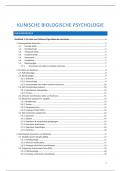Summary
Samenvatting klinisch biologisch psychologie (2024)
Dit is een uitgebreide samenvatting van het vak klinisch biologische psychologie gegeven in de eerste master klinisch psychologie aan de VUB. De samenvatting omvat alle informatie van de slides, lesnota's en afbeeldingen.
[Show more]
Preview 6 out of 82 pages
Uploaded on
April 18, 2024
Number of pages
82
Written in
2023/2024
Type
Summary
Institution
Vrije Universiteit Brussel (VUB)
Education
Klinische Psychologie
Course
Klinisch biologische psychologie (011481)
All documents for this subject (10)
$6.94
100% satisfaction guarantee
Immediately available after payment
Both online and in PDF
No strings attached
KLINISCHE BIOLOGISCHE PSYCHOLOGIE




